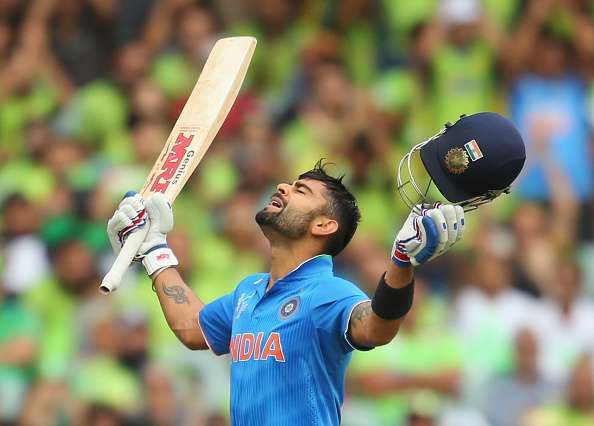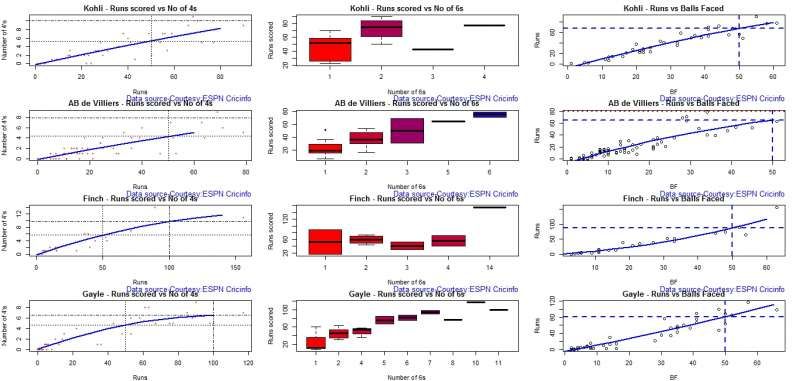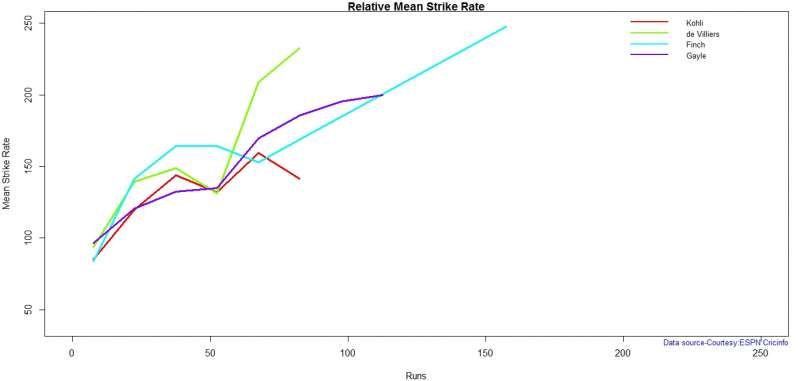
Stats: How Virat Kohli fares with the most destructive batsmen in T20 cricket
The World T20 2016 is closing in towards a very exciting culmination. Over the last few weeks, cricket lovers all over the world must have had their appetite full with so many interesting matches and some great performances by their favorite players.
We saw how Chris Gayle pulverized the English team with his swagger and deadly strokes, a heart thumping, nail-biting end to the India-Bangladesh game, Virat Kohli's maturity and histrionics on seeing India through in their group encounters with their arch rivals Pakistan, blistering performances by Andre Fletcher, Steve Smith, Shane Watson, Tamim Iqbal, Mohammad Shahzad, Joe Root to name a few.
I am sure many of the fans were disappointed to see AB de Villiers not firing up to the expectations (his only meaningful contribution has been against Afghanistan, where he scored a quick fire 64 runs).
When T20 first came into the picture, many critics were skeptical about its longevity and popularity, but over the years, the skeptics have been silenced by the soaring popularity of the shortest format of the game. Even India probably started to look into the T20 format seriously after their famous victory in the inaugural World T20 in 2007.
The IPL followed pretty soon, and now almost every major country has their version of the domestic T20 competition, where almost every other player participates and enjoys the popularity for themselves as well as the sponsors. This T20 World Cup has seen a fair bit of competition between bowlers and batsmen, although we usually prefer to see the batsmen basking in all the glory by ripping the bowlers apart in all parts of the ground.
Still, even at this juncture, it is probably safe to say that T20 is still predominantly a batsman's game.
During the Asia Cup 2016 as well as in the T20 World Cup, one name that is doing the round is Virat Kohli. He has shown immense maturity and calmness in pacing his innings and carrying India towards the gate of victory.
Not only he scores heavily, but also makes sure that the patch to victory becomes smoother by his judicious stroke-making backed with a strong sense of maturity and calmness. Kohli's achievements within a short span of his career get more accolades because of the fact that he performs supremely well while India is chasing, which makes his enviable record, even more pricey.
Being a statistician and a lover of numbers, I thought that, why not compare Kohli with the most destructive batsmen in T20 cricket, Chris Gayle, AB Devilliers as well the current number one T20 batsman in the ICC rankings, Aaron Finch. The analysis was conducted using R (www.r-project.org), a language and environment for statistical computing and graphics.
It is a GNU project, which is similar to the S language and environment which was developed at Bell Laboratories (formerly AT&T, now Lucent Technologies) by John Chambers and colleagues. R provides a wide variety of statistical (linear and nonlinear modelling, classical statistical tests, time-series analysis, classification, clustering, …) and graphical techniques, and is highly extensible.
The S language is often the vehicle of choice for research in statistical methodology, and R provides an Open Source route to participation in that activity. The analysis was conducted using the R package “cricketr” developed by Tinniam V Ganesh. This package uses the statistics info available in ESPN Cricinfo Statsguru.
The current version of this package can handle all formats of the game including Test, ODI and Twenty20 cricket. The ‘cricketr’ package has several functions that perform several different analyses on both batsmen and bowlers.
The package has functions that plot percentage frequency runs or wickets, runs likelihood for a batsman, relative run/strike rates of batsman and relative performance/economy rate for bowlers. Other interesting functions include batting performance moving average, forecast and a function to check whether the batsman/bowler is in in-form or out-of-form.
So let's take a look at how Kohli performs against the very best in the world of T20.
The first part of the analyses involved at looking for the number of 6’s, numbers of 4’s versus the runs scores and the scoring rate of each individual batsman.
The above graphical display conveys the information that Kohli hits approximately five boundaries on an average to reach a score of 50 in a match. This trend seems to be very similar in all the other batsmen compared with him in this analysis.
I don't think anyone would say at this juncture that Virat is a very destructive batsman in terms of pulverizing the opposition bowlers by hitting massive sixes. This is also evident from the above picture, which shows that he has hit only one six when he has scored between 30 to 60 runs in majority of the innings
When he went beyond the score of 60, there has been instances where he has hit two sixes. Interestingly, in few matches, where he scored some 40 odd and 80 odd runs, he scored those runs by hitting three to four sixes. So here is some evidence that may be given, a scenario where Virat scores a 100 or close to 100 in a game, he may hit more sixes than his usual average.
Now in a comparative scenario, we see that ABD hits, at least, three sixes when he scores between 30-70 runs in an inning. But given the similar scenario, if Virat Kohli hits two sixes, chances are that he will be ending up with a bigger score than ABD.
Finch, the number 1 batsman, shows a very interesting feature. Even when he scores below 60 in an inning, he hits three to four sixes to reach that score, displaying the destructive nature of this Aussie batsman. Obviously, the 14 sixes seem to be an anomaly in this case for Finch, which goes back to 2013 when he scored a massive 156 runs against England in Southampton.
Chris Gayle, on the other hand, seems to be a delight for us, as he is pretty consistent in terms of hitting sixes. The general trend in his innings is pretty clear from the graph that as he goes on to score higher, the number of sixes increases.
Thus, Virat Kohli probably needs to catch up with these stalwarts as far as T20 hitting is concerned, but again we never associated him with massive hits which are synonymous with someone like an ABD or Gayle who uses either weird improvisation, 360-degree hitting or brute raw power.
But apart from power, technique, consistency and match winning performances under tense pressure situations also matters equally and given the scenario that we have been encountering over the last few months, Virat is pretty much there in terms of providing those winning moments.
Relative mean strike-rate:
Let’s see how these batsmen compare in terms of relative mean strike rate:
Again, there is no big surprise as Finch has better strike rates than Kohli. However, one sees Kohli with almost same strike rate as that of ABD between scores of 40 to 50. ABD clearly beats his opponents in a massive way in scores between 60 to 80, where his strike rate is closing the 250 mark.
Between Gayle and Finch, Gayle has a better strike rate in scores near 100. However, one must salute Finch for that superhuman inning of 156 where he scored at a strike rate of 248. So it seems like Kohli may not be scoring runs as quickly as the very best in the world, also, his strike rate takes a steep dip when he tends to score more runs in an inning, but given his age and a long career ahead of him, we can always be hopeful.


